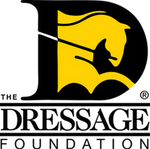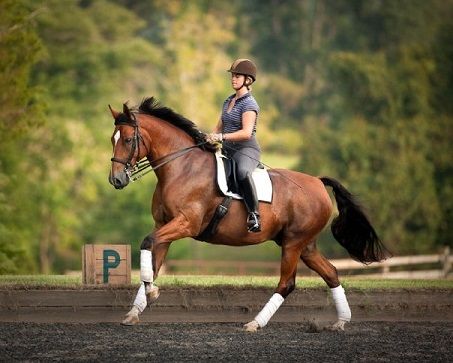
Photo by Pat Girard
Eliza's Day 1 Journal:
We started out our day at TyL Farm, owned by Kylee Lourie, and the home training base of Adrienne Lyle and Katie Duerrhammer. Kylee welcomed us to her amazing facility and talked with us a little about what is most important to her at her barn - camaraderie, horsemanship, and a supportive team atmosphere where everyone works hard and cheers for each other.
First Adrienne taught Quinn Iverson and Beckham; a 14-year-old gelding owned by Billie Davidson (Benetton Dream/Don Davidoff.) They work a lot on straightness - walking, halting, teaching him to stay aligned. Even in the halt, he likes to step his left front out, and that is the same misalignment he does in much of the work, so they just quietly work on that at the walk and halt to start. Make sure the bend is honest, and he doesn’t just pop the shoulder to the left or lean into the right when you ask for bend.
Challenge the changes. Ask for an 8 now instead of a pleasant 7. Can you get him off the left leg sooner on the diagonal?
Never make a correction within a flying change. The worst thing you can do is nag them or kick them. For this horse, they had to make the changes small and slow and balanced because he was so crooked, and now they can add more volume without upsetting him in his brain. In the show ring, she will probably tone it down slightly, but at home, they push him a little out of his comfort zone.
At the trot, RPMs have to stay up when they collect him. Otherwise, he gets too slow. He has such a huge trot. "Work him into the shape you want, activate, then relax your leg, and if he falls on the forehand, he gets a little consequence for that." Renvers when tracking left, so he can’t lean on that right shoulder.
Two ways to make him straight - either you move his butt off your left leg, or you move his shoulders over to the left and just keep playing till he finds his center.
"They have to know there’s a place where the pressure comes off. They won’t want to stay there if they’re only being held with pressure."
The issue is rarely the flying changes, it usually calls out other problems. So working on those issues instead of working on the changes is what will improve the actual changes. When he first came and got nervous in the tempis, he would suck back behind the leg.
Two options - move the canter bigger and easier on the diagonal or do a walk transition and make him walk to the contact on the diagonal correctly and in alignment.
Corrections are gradual because they’re not a punishment, they’re an explanation.
"I do a lot of walk work, it’s not everyone’s cup of tea, but I find it really helpful."
"When I’m teaching changes - I don’t do them on the diagonal until they can do them everywhere else - quarterline, made up line, wherever. Once they have a problem anticipating on the diagonal, it's very hard to fix."
Beckham has a very tricky walk - strong lateral tendency. They have improved it somewhat by using Spanish walk. They are happy now with a 6-6.5. Hopefully, they put enough “points in the bank” from the rest of her work that the walk is not going to ruin the score. For a rider Quinn’s age - getting the correct feel for GP work is what’s most important.
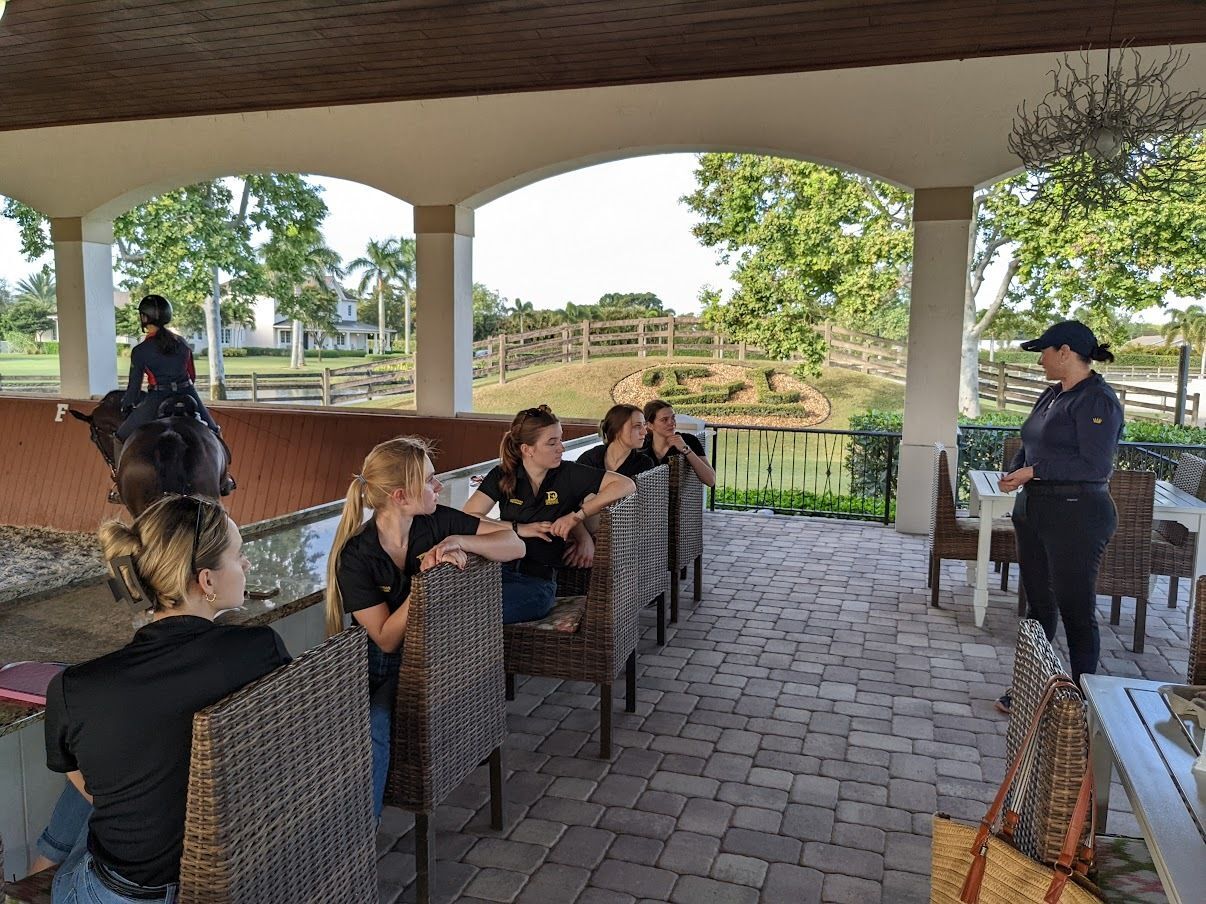
With TyL Farm owner, Kylee Lourie
Next Adrienne taught Katie Duerhammer on Fair Play “Player," a Fair Game/Sandro Hit coming 4-year-old. He spent the summer hacking around, and a groom rode him a lot.
All horses have a weaker/stronger side, his weaker side is right. So we start out a lot to the left, so I give him a chance for success. Start left, so you can “stack everything up” before going the harder direction.
Young wiggly horses (he is narrow) can make you get all over the place in your position, but Katie is trying to stay steady in her core and get narrow and centered.
If the connection is busy and broken early on, often because riders are trying to make them move big and impressive, it can be really hard to fix later. Connection in the mouth is a reflection of what’s happening in their brain.
"Taking a step back is not admitting defeat, it’s building a foundation so you can increase understanding- either in horses or riders." Katie Duerhammer
Next up Adrienne taught Quinn on Gremlin coming 8-year-old schooling pieces of PrixSG.
Super talented horse, very sensitive in connection. Naturally has a huge stride, so we’re always trying to teach him to compress and be smaller. He is one who needs very clear boundaries. He must be shorter in his body.
They are really picky on all the horses - babies to Grand Prix, when they take a walk break it has to be the best walk they have. So that when they show, it’s automatic.
Walk pirouette to half steps to canter pirouette exercise. He must learn to keep his hind legs farther under and get quicker.
The difference in this horse was remarkable from the start to the finish. He has a tricky conformation with a slightly long back, but he also has a ton of ability to sit down. It was amazing to see him transform from long and slow to compact and active behind.
Next up was a lesson for Christian Simonson on Zeaball Diawind (Furstenball/Zardin Firford.) This horse likes things to be super methodical and gradual. Easy, quiet warm up, and then gradually getting hind legs more under and pelvis to rotate through transitions within canter. Leg yield in canter to begin to loosen him up behind the saddle. Counter canter to make him sit more and get straighter.
Passage is an adding of energy not a taking back. If he’s strong on the left, MOLD him, make it more elastic. Don’t just get him off the left rein. In piaffe, he gets hot and quick in the hind leg but goes out too quickly. Hang out in the in-between space of small passage.
Little leg yielding in collection allows the horse to feel like they have somewhere for the pressure to go, and not like you’re driving them into a wall.
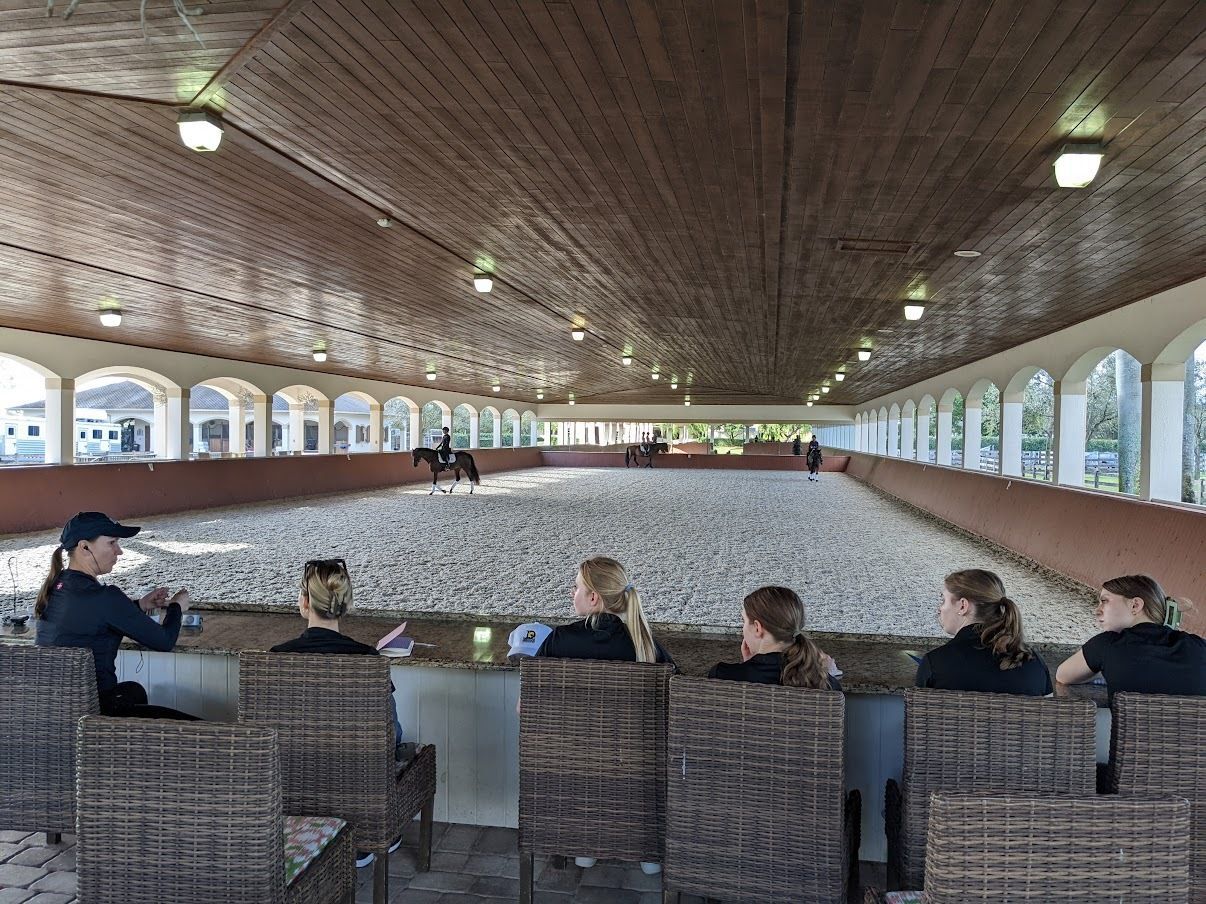
Watching a lesson with Adrienne Lyle
Then Adrienne rode Fürst Dream (Furstenball/Benetton Dream) - a coming 5-year-old stallion owned by Betsy Juliano. They have had him for 2 years. The goal in 2023 is to qualify for the five-year-old US Championships. "Dreamy" won the four-year-old championship last year at Lamplight.
Work him three days a week “real stuff” and the rest is hacking, lungeing, water treadmill, etc.
Adrienne explains to him balance, self-carriage, and adjustability in his body. Super willing horse with the most lovely attitude. They were looking for a young horse for Adrienne. Heinrich Brinkman sent a video, a rider friend of Adrienne's in Germany tried him, but because it was the height of Covid, they couldn't go see him in person. John Amber rode him when he first came because they were preparing for the Olympics, and Adrienne couldn't risk riding a young, unknown horse, even though he was very well-behaved.
Adrienne and Betsy agree that their goal is not the World Young Horse Championships. The goal is the US Championships and then slowly develop them to FEI. They don’t want to push them to be competitive at the World Young Horse Championships, because it doesn’t align with their training philosophy and goals.
Betsy Juliano owns 12 horses now. In 2010, Adrienne and Debbie came for one month to Florida and came to Havensafe, Betsy's barn. Betsy got to know Adrienne and Debbie and watched their training and was always impressed by their horsemanship and commitment to correct, classical training. In 2015 a syndicate was formed for Salvino. This was originally the brainchild of Akiko Yamazaki. In 2017, Betsy bought out the other owners and owns Salvino 100%.
With a sponsor, you have to ask why are they doing this. Is this their business? Sales? Betsy loves the horses and loves the process, the development is what she enjoys. She does not ever plan to sell the horses and doesn't buy stallions for breeding. Her long-term goals are to support Adrienne with horses that can make international teams for the US. For Morgan Klingensmith, Betsy wants to develop her as a rider to bring along horses as well. She is present every time Adrienne is working her horses unless she has a scheduling conflict.
She wants to start an international owners group for FEI here in the States. The US needs to have more of a presence in the international scene and get involved with trainers groups, and riders groups, and participate in meetings so we can have a voice.
Adrienne -
The biggest thing going into a big competition is to trust your training and not change what has gotten you there. Takes a long time to learn what works best for each horse - best after a day off? Best after two days of work? Tack walk first?
They charted Salvino's temps leading up to Tokyo because the heat and humidity were going to be so intense - how hot is he after 15 mins of work? 20 mins? If you need a 45 min warmup normally, but you can only work 20 mins until he gets too hot, you need to figure out how to get him at his best after only that amount of time. Salvino doesn’t like the heat, so they keep him cooler with AC units. He's a big, black horse with a big neck - he gets hotter sooner. He gets grumpy when it’s hot.
Not every horse is going to be a Grand Prix horse, and that’s ok. There’s a huge need for well-trained lower-level or small tour horses. Let that horse shine as a PSG schoolmaster instead of forcing him to do Grand Prix and having him be unhappy or injure himself.
Adrienne keeps up a fitness program outside of riding - Pilates, interval training, and physios that the team works with here in Wellington and on the road to big shows. It’s a non-negotiable for her because her body has to be comfortable, symmetrical, and supple.
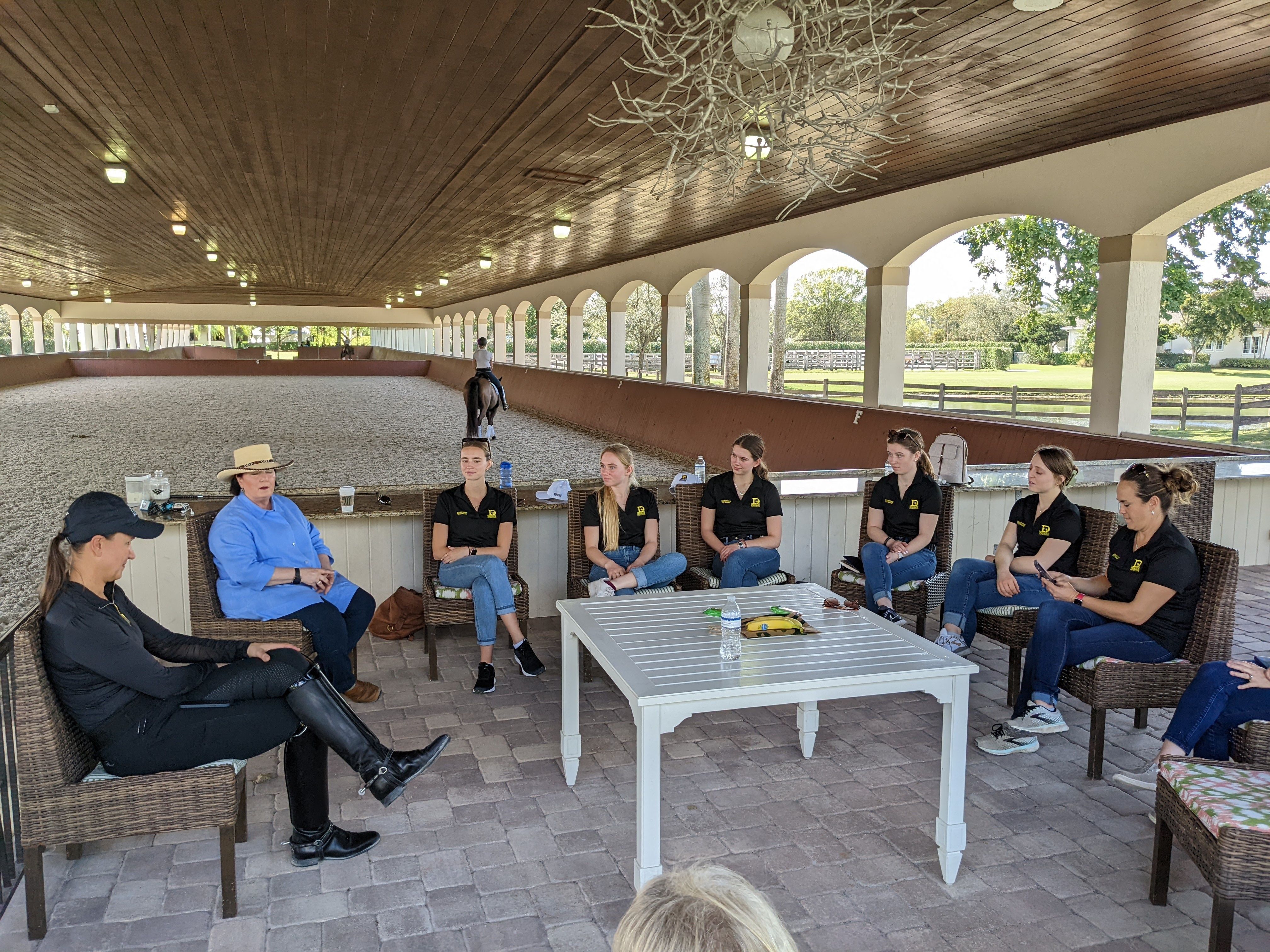
Chatting with Adrienne Lyle and Betsy Juliano
Afternoon, Day 1:
In the afternoon we visited Top Meadow Farm, where Kathy Connelly trains. This is a gorgeous place that used to be a jumper farm and is now only focused on dressage. They had a humongous covered with fabulous footing, and Kathy shared with us her approach to long lining.
Long lining is a chance to see your horse and for them to see you. You can see the whole body of the horse and see what they are really doing with parts of their body that you can’t see when you’re riding.
When you’re long lining you have to have a “soft eye” and a “hard eye” - the hard eye is watching the horse’s head and eyes and keeping you safe. The soft eye is taking in the whole horse and assesses the whole body.
If horses don’t do things it’s because:
They can’t (something hurts, they’re not strong enough, etc)
They don’t understand
So it's our job to explain things to them and help them to understand.
They’re very tactile and much more physically perceptive than humans.
The whip is a timing wand, not a punishment.
Usually, Kathy does something first (riding, lungeing, etc) and then long lining later.
Audio, visual and tactile is how the horses learn.
Touching the horse right behind the rider’s leg, she doesn't want the skin to twitch. If he twitches, he’s keeping his barrel too tight and won’t be able to piaffe well.
Balance spots - where your vertical axis intersects with their horizontal axis. The first thing we must do is create a balance - forward, light to the leg, straight.
Highly recommend having a front-end handler when you’re doing this. Work on the ground first, turn on the forehand, walk, halt, and be respectful of my space.
Short bits are better than a long session. You can take them out a couple of times a day, but super short, give them treats, and make it fun. Never make it boring.
For a cold/lazy horse - usually, they're lazy because they don’t understand, not because they’re thick-skinned. Use a turn on the forehand to loosen their trunk. Then use a bounce whip, not a thwack. A thwack will make them brace their body.
Understand the Trunkae nerves - right under the leg of the rider, most people use the whip and their leg too far back on the horse's barrel.
Horses' Hind legs close together and then forward, not forward first. So if they learn to get narrow but they're not stepping under enough, just take time. They must learn to lift through their shoulders and back, so the hind legs have somewhere to go farther under the body.
Kathy had all the YRs practice using the whip to knock down Dixie cups and learn the proper technique through the wrist. She learned long lining from Bachinger at the Spanish Riding School, and it's such a great tool to have in your toolbox.
Evening, Day 1:
Our day ended with a gorgeous dinner at Beth and Jen Baumert's home, where Margaret Duprey joined us. Margaret is a big supporter of dressage in the US and is donating up to $100,000 to TDF for this program specifically. The YRs were able to chat with her over dinner about her experiences as an owner and supporter of dressage horses and riders, show jumpers, and Para Equestrians. Jenny Johnson, executive director of TDF, and Sara Weiss, director of programs, joined us as well.
Huge thank you to everyone who allowed us to come today and learn so much!
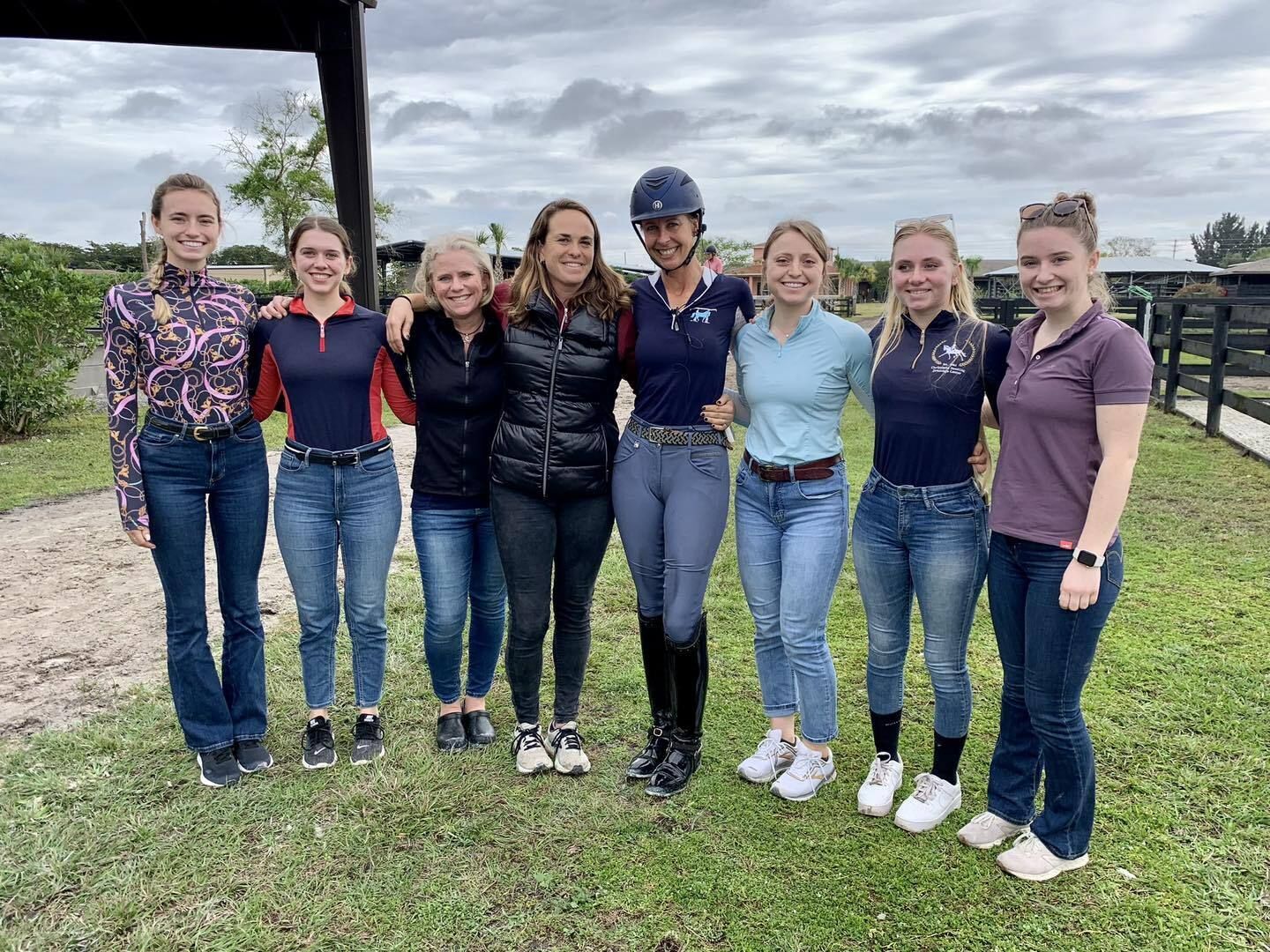
YRDP with JJ Tate
Eliza's Day 2 Journal:
Today we went to Poinciana Farm in Loxahatchee, owned by Jane Cleveland, and the winter training base for JJ Tate (and many other trainers!).
First JJ showed us, Montana - a 17-year-old gelding she got for $1. “When you train and live your life with integrity, amazing things happen. Always take every opportunity that you can, be kind, and stay true to yourself. The thing that will make you successful, whether you make a team or not, you can go to bed saying I did a great job today being a great trainer, a great teacher, a great boss, a great mom, whatever it is, you do your best.”
You make the ok horse good, the good horse great, and the great horse fantastic. And one day maybe you’ll get a fantastic horse and make it the best in the world.
Approach each horse as an individual within a solid system.
Each horse in my stable - I have to interpret what they’re saying to me. I’m not going to force the square peg into the round hole.
I always ask myself who am I doing this for? For the horse? For me? For the owner? The training has to align with my goals and stay clear.
Warm up - free, forward, and flowing.
This is a RIDING sport, not a HORSEING sport. So I have to work on my riding, instead of forcing the horse to do more or less of something.
Forward has to be a state of mind, not forcing them forward.
Every day we are building the horse’s vocabulary. In the beginning, it’s very basic - teaching super basic words and sentence structure. Eventually, you’re going to have a being (the horse) who has a Ph.D. in balance.
Three questions to ask every day:
Can I make your frame long and can I make your frame short?
How long a stride and how short a stride can I make?
Can I bend and go straight?
Think of these questions as dials - turning them up and down carefully each day and gradually more and more.
A horse evades in three ways:
Speed
Inversion
Crooked
A supple horse creates a strong horse.
Where is the major brace point? Where is your major weakness? My job is to educate.
What happens in the neck is information about what’s happening behind the bit. What you feel in his mouth is usually nothing to do with his mouth. Find the least common denominator.
Shoulder in can help improve the hocks
Haunches in can help improve the stifles
Renvers and half pass can really improve the pelvis
I’m a physical therapist and personal trainer for these horses.
The horse’s back is the weakest part of its whole body and we’re holding on to the most sensitive part. So we must make them round, so we create a strong arch. The arch is the strongest weight-bearing shape.
Three bascules:
Hocks to lumbar
Lumbar to withers
Withers to mouth
Must make all three stronger
I know I have to build a program to strengthen stifles and core because this horse has problems/weaknesses there. His natural tendency is a strong, bracing under neck, so I have to build the opposite muscles so he doesn’t feel the need to defend himself with his strong under neck.
I make daily “deposits in the bank” through steady, systematic work. When I go to the horse show, I can have a “spending spree” and ask for the biggest extensions, the smallest pirouettes, etc. But I can’t ask for that every day, because I won’t have any more money in the bank. I’ll use up the horse too quickly.
I want to make sure that the horse who leaves the arena today is the horse I want to come to the arena tomorrow. So important to build confidence.
Canter-trot and trot-canter help swing the horse’s back. Walk to canter and canter to walk builds engagement.
How to build a horse to Grand Prix - Strength and Skill. Some days are skill days and some days are strengthening days.
For good changes:
Good quality canter
Good quality half half
Good quality depart aid
Four channels of thoroughness:
LH to L bit
RH to R bit
LH to R bit
RH to L bit
I want to make sure the horse is “stacked up” on all four channels before I ride changes.
Shoulder in to renvers is a good way to check those channels
Walk to canter straight to the mirror in shoulder-fore to check straightness before changes.
If they’re getting crooked, more forward will help you straighten them somewhat. Like driving on the snow, if you’re starting to slip around, the best thing is to put your foot on the gas to get you out of there.
Next up we got to meet with Jane Cleveland, the owner of Poinciana. She gave us a fabulous tour, talking in depth with us about the design of the place.
Jane bought 13 acres of wood in 2018.
Jane had a long career in commercial real estate and ran the real estate department for Vanderbilt.
Designed the layout of the farm in painstaking detail, thinking through all the boarding barns she had been in over the years. What worked? What didn’t? How to utilize the space as efficiently as possible to cut down on labor.
Water management is absolutely critical.
The whole farm is calibrated for drainage.
Dug the lake out and used the fill to build up the barn area.
Labor, labor, labor!! The biggest thing to think about when building a barn is how can you be efficient.
This land’s soil is four feet of fine sand.
Reverse osmosis water system with a generator because water is naturally heavy in sulfur.
Manure is taken away and burned, taken to solid waste.
Extra wide aisle - 16’ so that dump trailer can go through and horses can still have horses heads out and have space to maneuver.
All traffic is in the front, so it stays quiet back by training. Trailers parked by the road.
The driveway is a circle that’s big enough for the biggest tractor-trailer. They started with the turning radius of a tractor-trailer and built the barn back from there.
330,000 tons of manure come out of Wellington each year. Right now it all goes to solid waste and gets burned. It’s a huge problem.
Day two, Afternoon:
After our amazing morning at Poinciana, we did a quick tour of Helgstrand with Amanda Perkowski. Amanda was a participant in this trip years ago and has been working for Helgstrand for four years. She was so generous with her time and answered all our questions. Tomorrow we get to cheer her on in the CDI!
Later in the afternoon, we went to Global to watch Jennifer Baumert warm-up Rebecca Hart, one of the top US Para Dressage riders. We learned a lot about Para, and we got to watch many incredible riders and their horses.
Day two, evening:
For dinner, we went to a yummy Mexican restaurant and ate with Dr. Hilary Clayton and Katie Foster. Katie was a participant in this trip about 10 years ago. She is now a sought-after trainer in Michigan and works closely with Dr. Clayton. Hilary Clayton was fascinating to chat with. She has done much biomechanics research and scientifically studied some of our dressage principles. She is just an amazing wealth of knowledge!!!
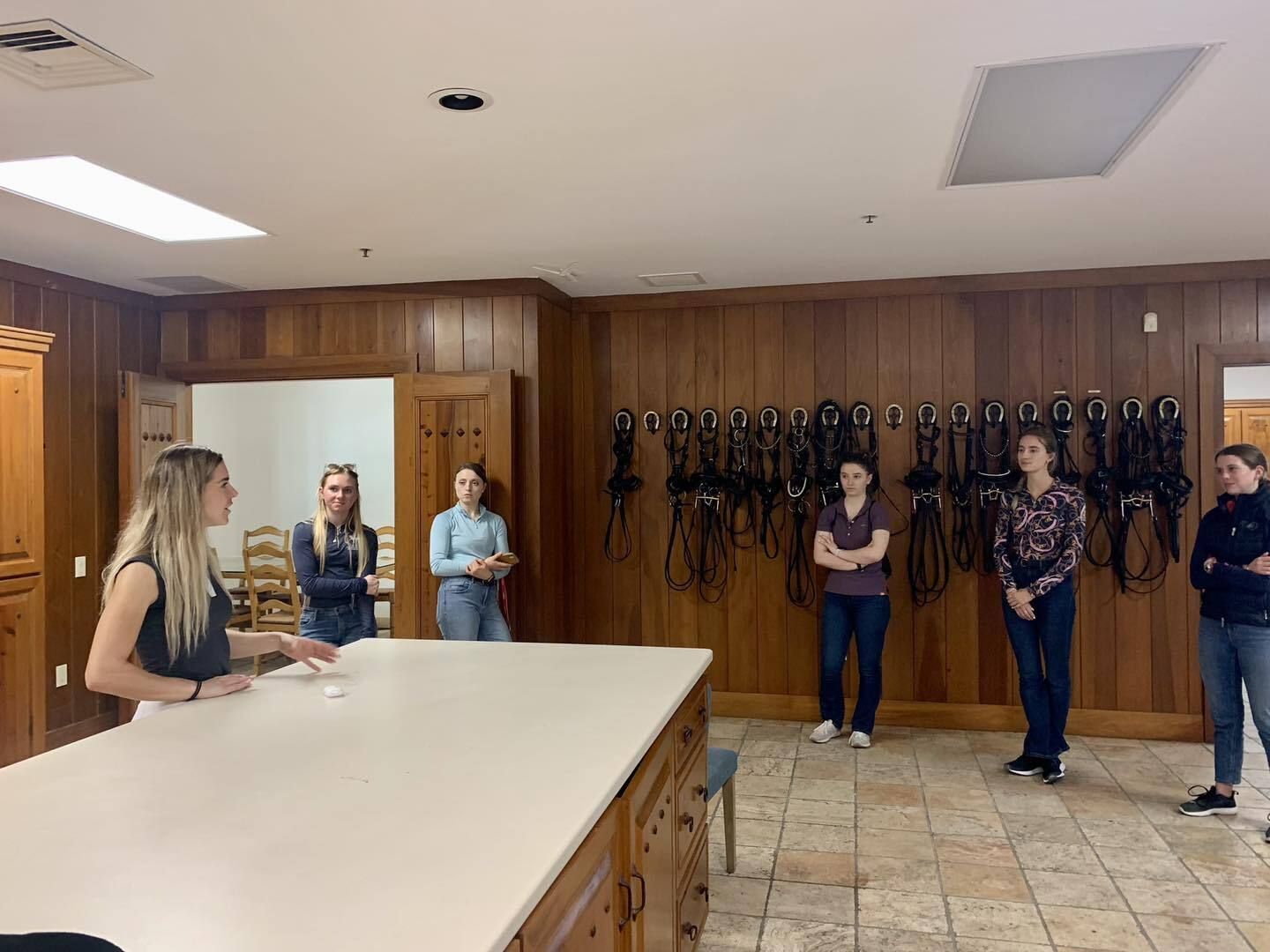
Tour of Helgstrand with Amanda Perkowski
Eliza's Day 3 Journal:
Wow, what a full day at Global! We woke up to a super chilly morning - in the 50s! (Sorry everyone in the North, I already sound like I’m from Florida) And we headed to the Global showgrounds nice and early, so we could watch Ali Brock warm-up Amanda Perkowski.
Ali was on our 2016 Olympic team and is a very sought-after coach now, working with a lot of top riders. Amanda was riding Sonata MF (Sir Donnerhall/Don Principe) in Intermediate 1. She had a beautiful ride and ended up second with over 70%.
We then sat down for breakfast with Reese Koffler. Reese is a Grand Prix trainer, rider, and instructor, who has been coming to Florida for over 20 years now. She gave the group great advice about doing this professionally. She urged them to focus on their own education now and then gradually start to do more teaching and training. She had lots to say about client relations, and how to value yourself and not allow clients to take over your time or disrespect you.
We had the most amazing table right in front of E, up in the VIP tent. Adequan very generously donated it for the second year in a row, and we are so grateful. It gave us a home base and a comfortable place to meet with these trainers. Plus breakfast, lunch, and dinner right there. So we grabbed another yummy coffee and headed off to watch Ali coach Amanda on her second Intermediate 1 horse.
When Amanda’s ride was done, we sat down with Ali and learned about her story. She began as a working student for Sue Blinks and groomed for her at the Olympics and other top competitions. Her hard work and dedication eventually gave her the opportunity to take over riding for the Kundruns, the sponsors who had supported Sue, and who still support Ali. Ali echoed Reese in urging the group to focus on their riding/training education now. It’s easy to get wowed by these big riders with sponsors and fancy horses, but their job now is to learn every day how to be better riders on whatever horses they have in front of them. She was adamant that first and foremost they work on their seat, as it’s your means of communication, and you can only communicate effectively with your horse when you sit correctly. Ali was kind, honest and very straightforward, which are qualities that have made her so sought after by many riders. Ali coaches many of the riders we talked with on this trip and previous YR Dream trips- Amanda, JJ, Lauren Sprieser, and David Marcus.
Next, we had lunch with Charlotte Bredahl, our Development Coach for the US. Charlotte led this trip when I was a YR and then led it twice after, so she is a big supporter of the program. She explained to the group how her job works and the pipeline through which riders and horses come up and “get seen” by the US Coaches - Christine Traurig (young horses), George Williams (youth riders), and now Ali Brock is beginning to help some as another development coach. Charlotte spends six months in Florida and six months in California. She also does quite a lot of virtual lessons, and she said she mostly just uses FaceTime for that, as it’s the easiest and most ubiquitous.
We were able to chat with Lauren Sprieser quickly, who is here competing in the CDI Grand Prix. And we got to watch Jen Williams at a national Gran Prix on Joppe, who we will see tomorrow!
Friday night is the freestyle under the lights, so we dressed up and came back to watch that, which was so fun. The tent was so packed and loud that it was hard to focus on the music sometimes! But it was a great opportunity to see some super rides. Kerrigan Gluch on Mejorano HGF, a beautiful PRE stallion owned by Hampton Green Farm, stood out with their incredible piaffe and pirouettes. Frederic Wandres from Germany won the class on Bluetooth OLD (Bordeaux/Riccione) with over 81%, and his ride was definitely at another level - just smooth, steady, confident, and brimming with power.
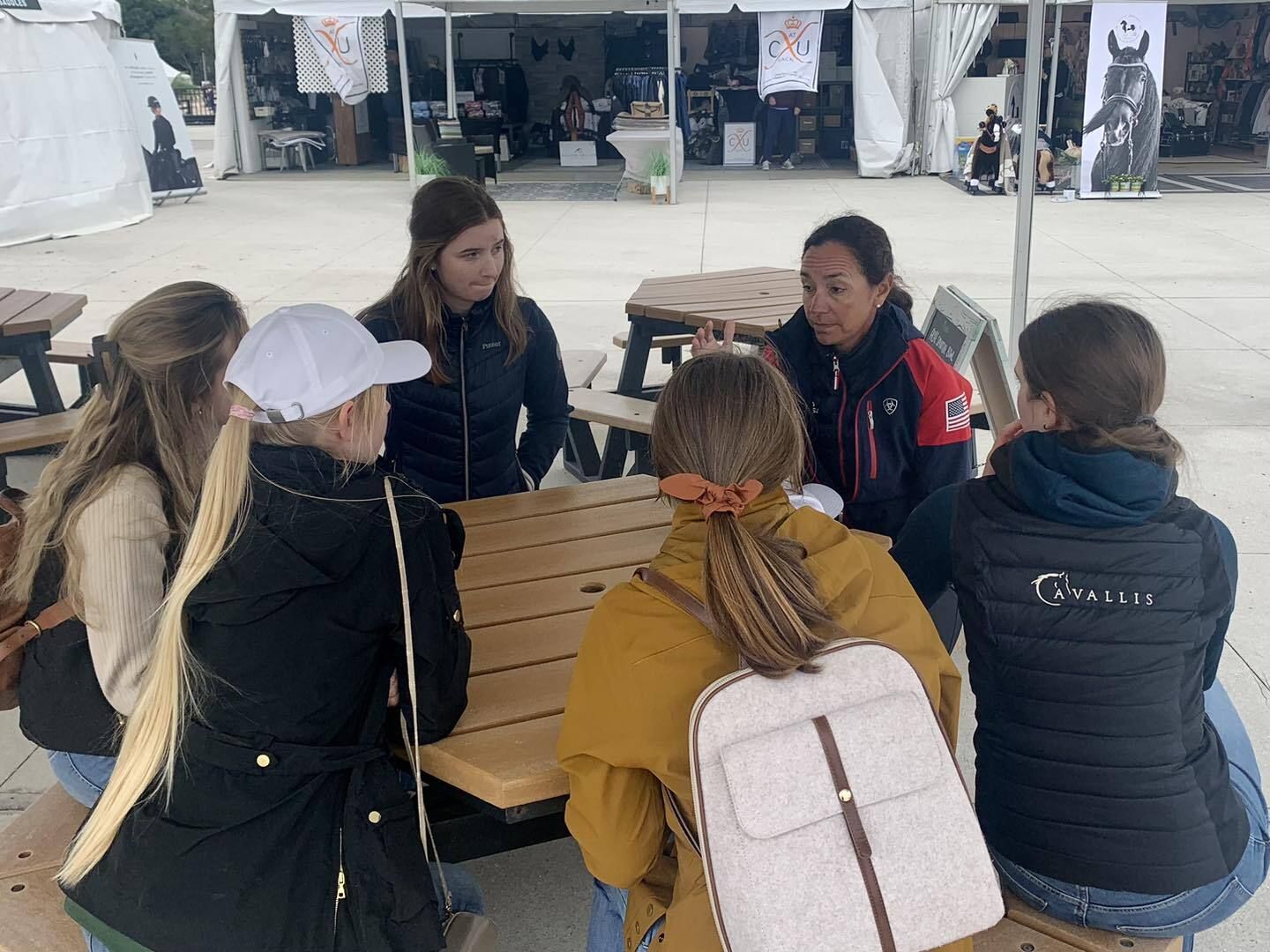
Learning from Ali Brock at Global
Eliza's Day 4 Journal:
We dragged ourselves out of bed this morning and headed to Oded Shimoni’s barn, where we watched Jen Williams training. Jen is from Washington, where three of the girls (and Jen Verharen, my fellow chaperone) are from, so it was really special for them to meet her and get to spend a lot of time watching and asking questions.
Jen rode Quarterline (Quarterline/Sir Donnerhall), a horse she is competing at Grand Prix, which is owned by Oded, who coaches her. Jen showed us all the Grand Prix work and talked with us for a long time afterward about how she approaches this horse in particular, and all horses in her training. She said this guy would get nervous and braced when he felt like he was being pressed from a strong leg into an unyielding hand, and then he would brace and climb with his neck. She first had to teach him (on the ground) that he was to yield to light pressure on the bit. If she took the reins by his mouth and put some pressure, he had to drop his head - not necessarily flexed in the pool, but he had to go down, not up, and not just hold against her pressure. This seems very obvious, but she says it’s often the first thing she does with horses when she gets them, and so many of them don’t understand.
She also talked about being strict with herself about using light aids. She thinks of her aids as 0-10, 0 being no pressure and 10 as the strongest aid you are capable of. And she wants to constantly make herself go back to using a 1. She says she finds so many people just live at a 5 or 6 constantly. But the horse can learn to respond to the lighter aid, and they will always go better that way. She gave the example of using simple transitions within the trot where she brings the horse back as he approaches the corners to such a small trot that he wants to break to walk, and then she just tries with a “1 aid” to say, Nope, keep trotting, and then back out again. And then the same thing next corner. Repeat until you can bring them back from a 1, and send them forward from a 1. The clarity for the horse will always make them happier to work for you. There are very few who are truly lazy, most just don’t understand.
Jen then showed us some work in hand with her top Grand Prix horse, Joppe K. Joppe got over 73% in the national Grand Prix the day before, so he was having a light day today. He came out with a surcingle and bridle and was hand-walked for a long time because we just had so many questions for Jen! (Sorry to her groom for making you walk three miles while we talked!!)
Jen holds the reins over the neck and into her left hand when going left, so she walks backward by the horse’s mouth. This is the same way that I was taught, but there are different ways to do this, and some people use side reins, have another person walk by the horse’s head, etc. But this way is the easiest because you can hop off and do it without adding any equipment or needing a second person. She did say, however, that in the beginning, sometimes having side reins on can be very useful, especially if the horse is strong or blows through you.
Jen’s work in hand starts out very simple - they must walk forward when she walks and halt when she halts. They have to immediately respond and walk with her, and if they are slow, they get a tap with the whip. And if they are slow to halt, they get a stronger aid to remind them to respect her space and not walk past her on the ground. Once they are doing reliable walk and halt transitions, she can move on. But so often horses need this piece clarified. And this can be done when they are very young - even before you’re thinking of piaffe. Consider the way your horse walks with you out to the paddock. All of that is training.
She then works to control the length of the steps as the horse walks with her. Can I shorten the steps in the walk without the horse quitting? And eventually, she can shorten them so small that they are 2” steps with the front legs. And then can I add activity a little at a time without the horse blowing through me. This way they are “begging” to do half steps (forward piaffe) instead of you whacking them to make it happen.
Jen was so generous in answering all our questions and hung out with us for a long time. She shared ideas on partnerships and syndications, managing client relationships, managing relationships with your coach, balancing time with your family, etc. Huge thanks to her for all the time she spent with us.
Next, we headed back to Global to meet with “The Bills.” Bill McMullin and Bill Warren are partners in life and business. They are both excellent trainers and judges. They say with us and told us so much info about judging and the USDF Instructor Certification Program.
Bill Warren is an international-level judge now, and he spent a lot of time with the group, talking about his experiences as a judge and then judging rides for us while they were happening in the ring. He was also so generous with his time and answered all our questions. Getting a judge’s perspective is so valuable, and all the girls were able to see just what a hard job it is!
The girls once again presented awards for the Para riders, which was an absolute honor. Then we headed out to our last dinner. JJ Tate and her husband, Richard Malmgren, joined us for dinner at a yummy Thai and sushi place. The girls had not gotten a chance to ask JJ all the questions they had, so it was so sweet of her to join us for dinner! Richard is an expert on long lining and learned from Bo Jena, the long-time Swedish coach. So, it was fun to chat about that with him as well.
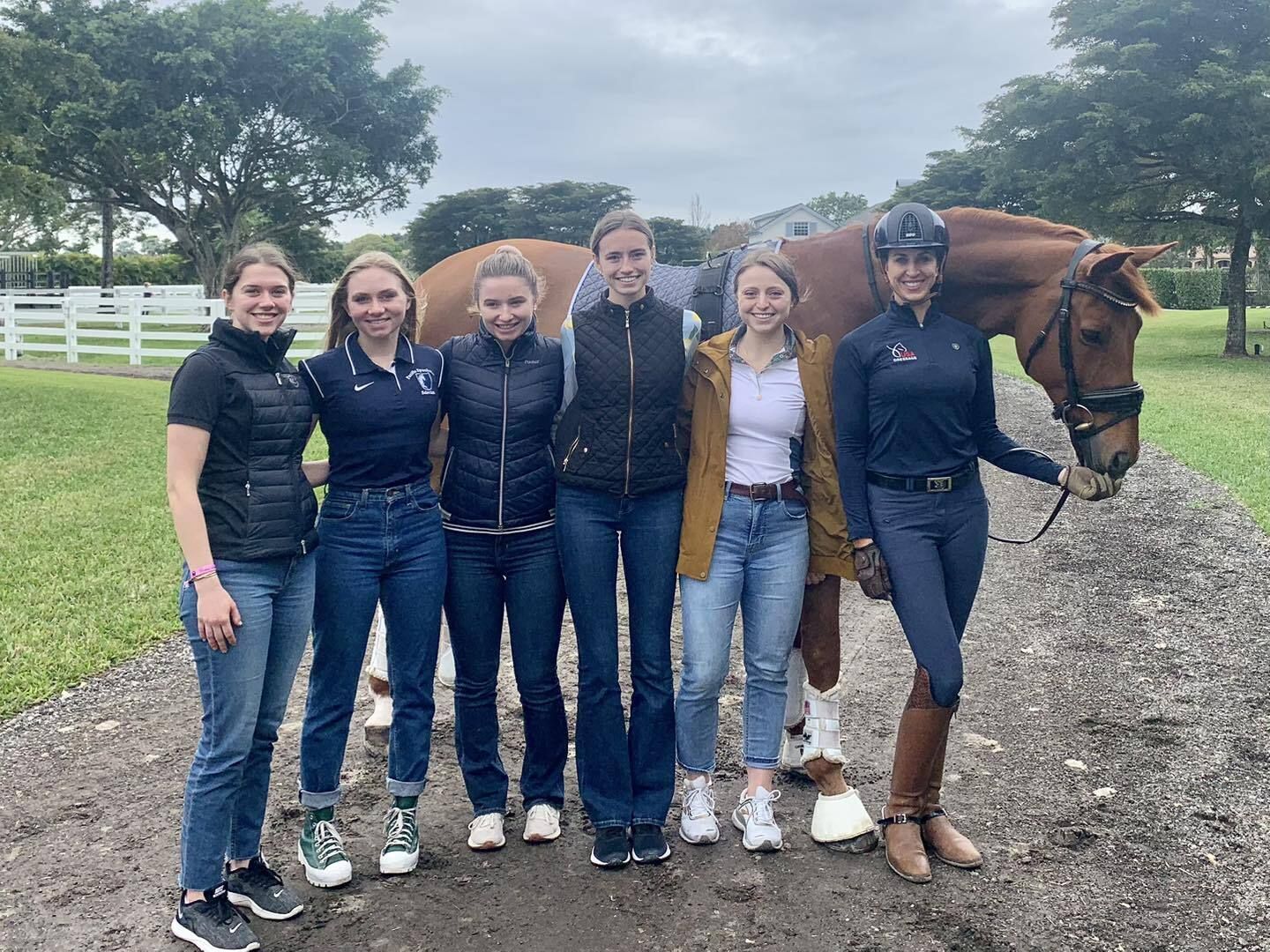
With Jennifer Williams
Eliza's Wrap-Up:
We are all heading home tomorrow exhausted but so inspired. Massive thanks to TDF and all the donors who make this trip possible. These five young women were able to have this experience without paying a dime. This kind of trip could never have been possible for these up-and-coming dressage riders without the generosity of The Dressage Foundation. I hope reading these notes is helpful, and I hope you will consider donating to TDF so that others can participate in this trip (and many other grants they make available) in the future.
